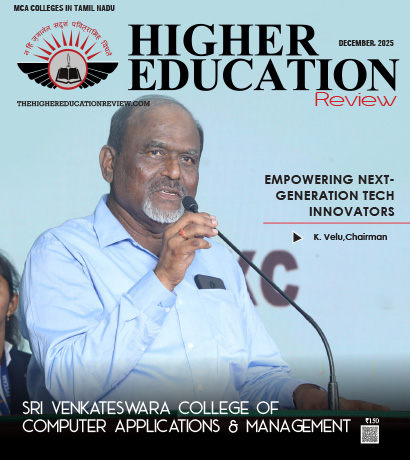Optimizing Talent Supply Chains: Aligning with Market Demands and AI Trends
 In a recent interaction with Higher Education Review, Rajesh Balasubramanian, EVP & Global head-talent supply chain, Hexaware Technologies shared his views on the challenges HR departments face when implementing digital transformation initiatives, how the talent acquisition strategy has evolved in response to recent market disruptions and more.
In a recent interaction with Higher Education Review, Rajesh Balasubramanian, EVP & Global head-talent supply chain, Hexaware Technologies shared his views on the challenges HR departments face when implementing digital transformation initiatives, how the talent acquisition strategy has evolved in response to recent market disruptions and more.
What challenges do HR departments face when implementing digital transformation initiatives, and how can they overcome them?
Transformation either in HR, digital, or any other domain should be driven by a clear as well as compelling purpose. Although transformation initiatives are launched often to check a box, they fail to engage as well as motivate teams. The lack of understanding of the true purpose of the initiative is one of the fundamental problems most teams face during their transformative journey. To be successful in the transformation process, the purpose should be articulated as well as well-rounded and this should address both the employees’ aspirations as well as the organization's requirements.
Purposeful transformation initiatives must address specific problems within the firms while also appealing to as well as enhancing the profiles of the employees who are involved. Successful programs in my current as well as the previous organizations that I have worked for had a clear, and well-rounded purpose. This ensures that both the employee as well as the organization benefit, fostering a sense of commitment and ownership.
The biggest challenge in a transformation initiative is effective change management. But, unfortunately, most organizations treat change management as an afterthought and address it only when the project is nearing completion. And, this approach is fundamentally flawed. Hence, organizations should ensure that change management should be an integral part of the transformation process from day one.
For any transformation to be deemed successful, it must yield tangible benefits, which means that the initiatives’ outcomes should be significant & measurable. For instance, in any digital transformation project, one of the main goals should be to improve efficiency & productivity. Tangible benefits realize that it serves as the validation of transformation effort. Therefore, the realization of tangible benefits is a validation of the transformation effort. It also demonstrates that the initiative has not only met its stated objectives but it has also delivered the real value to the firm.
How has your talent acquisition strategy evolved in response to recent market disruptions? What steps are to be taken to remain agile and responsive to sudden changes in talent demands?
The principle that what has brought us to our current state will not suffice to take us to our desired future underscores the necessity for constant growth and evolution in all our endeavors and this includes talent acquisition & staffing as well. And, this continuous enhancement is vital to keep up with the changing demands & achieving our goals.
Five aspects help in achieving this. Firstly, a key focus is to look at how the talent acquisition team is structured & aligned with the recruitment process. The task of breaking down processes into manageable components ensures control & governance. For instance, there are three fundamental phases/steps in a classic recruitment process which include moving from demand to selecting the candidate, making an offer, and lastly converting the offer into a hire. The second factor is to build an ongoing strategy, which includes brand building, community engagement, pipeline creation as well as capacity expansion. To maintain a competitive edge, it is important to build capacity & improve productivity. The third aspect is to develop diverse hiring channels. This comprises enhancing internal referrals, refining processes and forming dedicated execution teams. The internal sourcing teams that engage actively on LinkedIn platforms are crucial. Furthermore, a robust partner network that helps in ensuring a steady flow of talent facilitates in balancing numerous hiring channels to be readily accessible. The fourth important aspect includes targeting specific areas, locations, and skills. The last aspect include the investment in tools, automation, technology as well as team training. Building a deployable bench, and improving team capabilities through training are crucial for weathering any volatility. Hence, continuously evolving talent acquisition strategies across these five aspects helps firms ensure that they remain agile, competitive & prepared to face any kind of challenges and seize the opportunity.
What emerging AI trends do you foresee having the most significant impact on talent acquisition in the next few years?
With the advent of AI, the recruitment landscape has evolved significantly. It has shifted from manual processes to automated, intelligent systems. In the past, recruiters used to manually write search strings for job portals but today, AI enables automatic, context-rich matching of job descriptions with candidate profiles, rendering a match score for streamlining the sourcing process.
The impact of AI extends to the interview process with AI/ML backed modules for evaluation & proctoring. Although the recruitment industry has still not embraced AI for evaluations completely, the potential of AI to reduce subjectivity & handle several interviews simultaneously makes a huge difference. However, it cannot completely replace human judgement, specifically in roles that need nuanced understanding & dynamic demands.
Although AI can help in managing several tasks, some aspects such as final negotiations, as well as personalized candidate interactions need human touch. Therefore, the key is to integrate AI thoughtfully, by leveraging its strengths and retaining important human elements.

